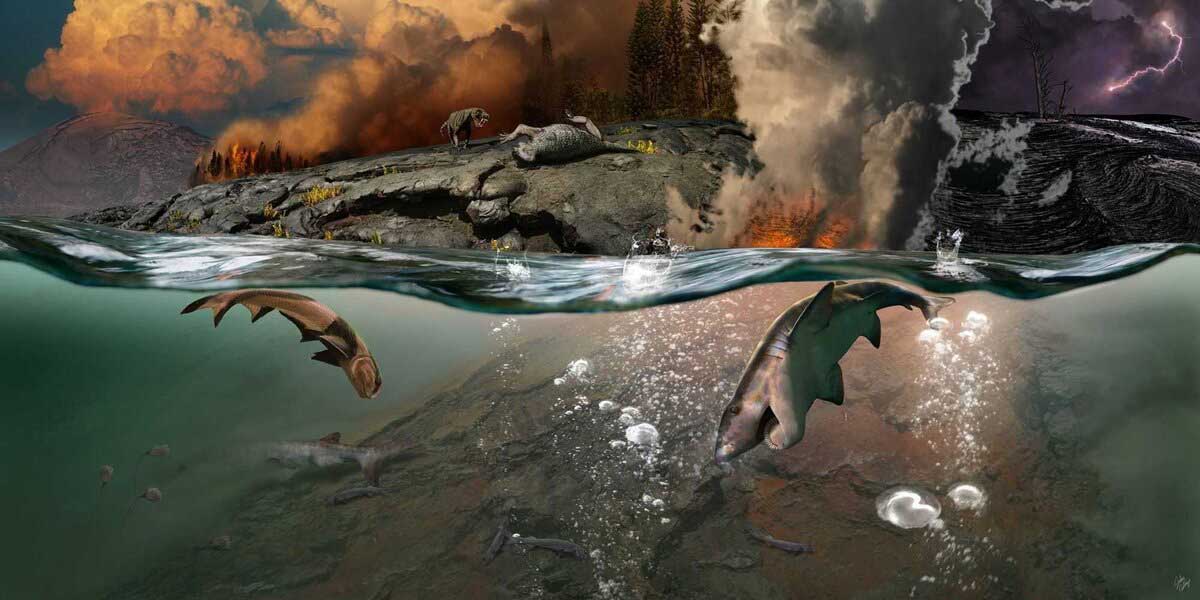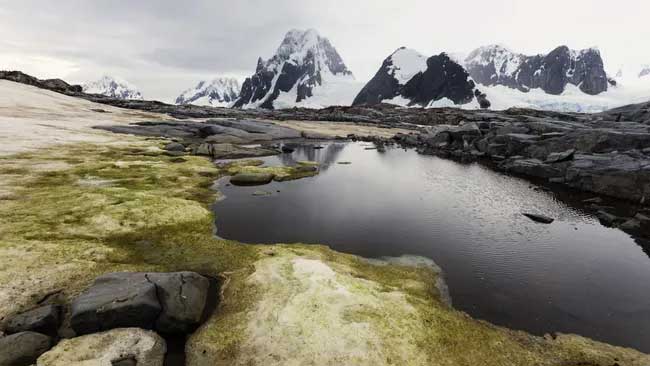Exceptionally preserved plant fossils of 350 million-year-old strange bushy trees have been discovered in southeastern Canada. In the UK, researchers have discovered a fossil forest of small, palm-like trees and arthropod tracks dating back to the Middle Devonian. Petrified trees discovered by chance in southwest England belong to the oldest known forest on Earth, a new study has found. The 390-million-year-old fossils displace the 386-million-year-old Gilboa Fossil Forest in New York state as the oldest known forest in the world.
In Britain, researchers have discovered a fossil forest with small, palm-like trees and arthropod tracks dating to the Middle Devonian. The new discovery highlights the differences between the two ecosystems, suggesting that the forests went from relatively primitive to established in just a few million years, said Neil Davies, lead author of the new study, published Feb. 23 in the Journal of the Geological Society.

An illustration of what trees in the earliest forest on Earth might have looked like. Peter Giesen/Chris Berry
This now-extinct type of plant, known as cladoxylopsids, is thought to be closely related to ferns and sphenopsids (horsetails). “They look like palms, but they’re not related to palms,” Davis said. “They have a long central stem and what look like palm fronds coming off, but those palm fronds aren’t actually leaves — they’re just lots of little branches.”
The trees, with their branched crowns, reached heights of 6.5 to 13 feet (2 to 4 meters), so “it was not a very tall forest,” Davis said.
Fossil trees are preserved both as hollow trunks filled with sediment and as fallen logs that have been flattened over the eons — like “casts inside the sediment,” Davis said. He added that small scars where branches were attached to the trees are still visible.
Davis and his colleagues stumbled upon the forest remnants while doing fieldwork in the Hangman Sandstone Formation, which dates back to the Middle Devonian period (393 million to 383 million years ago). During the Devonian period, what is now Britain was part of a continent called Laurentia, which was just below the equator, meaning the climate was warm and dry, Davis said.

Newly discovered fossil trees belong to the oldest known forest in the world. Christopher Berry
“When I first saw the photos of the tree trunks, I knew immediately what they were based on 30 years of studying this type of tree around the world,” study co-author Christopher Berry, a paleobotanist and senior lecturer at Cardiff University in the U.K., said in a statement. “It was amazing to see them so close to home. But the most revealing insight comes when you first see these trees in the places where they grew.”
Older trees exist in other parts of the world, with the first plants appearing on land 500 million years ago, but this new discovery is the earliest example of a forest where trees grow close together and in clumps.
“We found rocks where trees were growing next to each other in a particular area,” Davis said. “So we’re looking at an image where we can tell for sure that trees were growing in that particular area, and the sediment we’re looking at is the forest floor.”

Some fossils still show scars where branches were attached to trees. Neil Davies
Among the fossil trees, the researchers found tracks belonging to small Devonian creatures. “There’s nothing bigger than a lot of little arthropods roaming the land at this time,” Davis said. “There might be a few more amphibian-like creatures and fish in some of the lakes and rivers nearby.”
Although the researchers initially set out to study the sediments, the chance discovery of fossil trees may reveal a turning point in Devonian plant ecology. “It kind of suggests that there was a sudden takeoff in forested environments around 390 million years ago,” Davis said.
Exceptionally preserved plant fossils of strange, bushy trees have been discovered in southeastern Canada, new research suggests. The ancient trees are unlike anything scientists have ever seen and may be examples of evolutionary experiments. The rare tree fossils, preserved with their leaves, have an architecture unlike any plant known today and represent the earliest evidence that small trees grew beneath the forest canopy.
An earthquake 350 million years ago knocked down trees and buried them in a mud bath, leaving near-perfect imprints of their trunks and leaves in sediments at the bottom of what was then a lake. Geologists discovered the first fossilized tree while excavating a quarry in New Brunswick in 2017 and have since unearthed four more nearly identical specimens.

Sanfordiacaulis trees
Typically, only the trunks of ancient trees are preserved in the fossil record. But the new discovery shows a dense canopy of more than 250 leaves crowded around the top 30 inches (75 centimeters) of a thin, unbranched tree trunk that was about 8.7 feet (2.7 meters) tall. The leaves grew up to 9.8 feet (3 meters) long and extended from the trunk in “tightly compressed spirals,” according to a study published Friday (Feb. 2) in the journal Current Biology .
The trees, called Sanfordiacaulis, likely evolved this spiral structure to maximize the amount of sunlight the leaves captured for photosynthesis, the researchers wrote in their study. Their shorter stature also suggests that these plants are the earliest example of smaller trees growing under the canopy of taller trees.

Tree leaves are very rarely preserved as fossils, but this specimen shows the remains of a canopy. Matthew Stimson
The reconstruction of these plants “distorts our understanding of how trees are organized and grow,” Gastaldo said. “Their growth architecture is similar to but distinctly different from two tree models found in the modern tropics,” including a small number of tree ferns, gymnosperms (plants with open seeds) and flowering plants, he said. But these modern plants have fewer leaves in their crowns — 15 to 20 in the case of tree ferns and palms, he added.
According to Gastaldo, Sanfordiacaulis may have stood out among Carboniferous vegetation (359 to 299 million years ago) in the same way that quiver trees (Aloidendron dichotomum, formerly Aloe dichotoma) and baobabs (Adansonia) stand out today.

Olivia King, who helped discover the new fossils, lies next to one of the Sanfordiacaulis specimens. Matthew Stimson
“We think of quiver trees and baobabs as oddities compared to the rest of the angiosperms (flowering plants),” he said. “These oddities existed in other ancient plant groups that lived long before flowering plants appeared on the planet, but we have no clues about their oddities unless there was a very rare event that preserved the plant intact.”
Plants diversified significantly during the Devonian period (419 to 359 million years ago) and the Carboniferous period, according to the study. The strange fossils may be an example of an evolutionary experiment from that time that ultimately failed, Gastaldo said. “The evolution of the plant kingdom has gone through many different experimental forms that were successful for a few million years or more, but have not stood the test of time,” he said.






